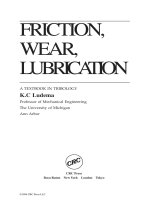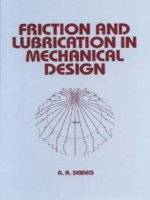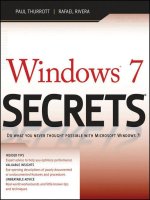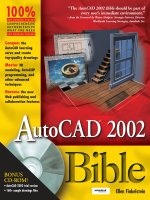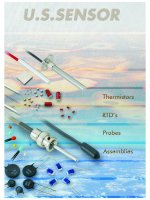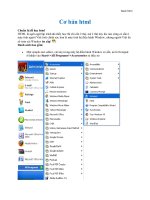Tài liệu Friction, Wear, Lubrication P1 doc
Bạn đang xem bản rút gọn của tài liệu. Xem và tải ngay bản đầy đủ của tài liệu tại đây (466.04 KB, 30 trang )
FRICTION,
WEAR,
LUBRICATION
A
TEXTBOOK IN TRIBOLOGY
K.C Ludema
Pr
ofessor of Mechanical Engineering
The University of Michigan
Ann Arbor
CRC Press
Boca Raton New York London Tokyo
©1996 CRC Press LLC
The co
ver background is a photograph of a steel surface (light blue) partially covered with streaks
of “protective” film due to sliding in engine oil. The image was created by a polarizing interference
(Françon) microscope objective (25
×
) with about 40
×
further magnification.
The graph on the front cover shows that the “protective” film builds up progressively and, if it
functions quickly enough, it will prevent scuffing failure of the sliding surface.
Acquiring Editor: Norm Stanton
Editorial Assistant Jennifer Petralia
Project Editor: Gail Renard
Marketing Manager: Susie Carlisle
Cover design: Denise Craig
PrePress: Kevin Luong
Manufacturing: Sheri Schwartz
Library of Congr
ess Cataloging-in-Publication Data
Ludema, K.C
Friction, wear
, lubrication : a textbook in tribology / by K.C Ludema.
p. cm.
Includes bibliographical references and index.
ISBN 0-8493-2685-0 (alk. paper)
1. Tribology.
TJ 1075.L84 1996
621.8
′
9—dc20 96-12440CIP
This book contains information obtained from authentic and highly regarded sources. Reprinted
material is quoted with permission, and sources are indicated. A wide variety of references are listed.
Reasonable efforts have been made to publish reliable data and information, but the author and the
publisher cannot assume responsibility for the validity of all materials or for the consequences of their
use.
Neither this book nor any part may be reproduced or transmitted in any form or by any means,
electronic or mechanical, including photocopying, microfilming, and recording, or by any informa
-
tion storage or retrieval system, without prior permission in writing from the publisher.
The consent of CRC Press does not extend to copying for general distribution, for promotion, for
creating new works, or for resale. Specific permission must be obtained in writing from CRC Press
for such copying.
Direct all inquiries to CRC Press, Inc., 2000 Corporate Blvd., N.W., Boca Raton, Florida 33431.
© 1996 by CRC Press, Inc.
No claim to original U.S. Government works
International Standard Book Number 0-8493-2685-0
Library of Congress Card Number 96-12440
Printed in the United States of America 1 2 3 4 5 6 7 8 9 0
Printed on acid-free paper
©1996 CRC Press LLC
ABOUT
THE AUTHOR
K
enneth C Ludema is Professor of Mechanical Engineering at the University
of Michigan in Ann Arbor. He holds a B.S. degree from Calvin College in Grand
Rapids, Michigan, an M.S. and Ph.D. from the University of Michigan, and a
Ph.D. from Cambridge University. He has been on the faculty of the University
of Michigan since 1962 and has taught courses in materials, manufacturing
processes, and tribology.
Dr. Ludema, along with his students, has published more than 75 papers,
primarily on mechanisms of friction and boundary lubrication.
©1996 CRC Press LLC
ABOUT
THIS BOOK
This book is intended primarily to be used as a te
xtbook, written on the level
of senior and graduate students with proficiency in engineering or sciences. It is
intended to bring everyone who wants to solve problems in friction and wear to
the same understanding of what is (and, more important, what is not) involved.
Most engineers and scientists have learned a few simple truths about friction and
wear, few of which seem relevant when problems arise. It turns out that the
“truths” are often too simple and couched too much in the terms of the academic
discipline in which they have been taught. This book suggests a different
approach, namely, to explore the tribological behavior of systems by well-
designed experiments and tests, and to develop your own conclusions.
One useful way to control
friction
and
wear
is by
lubrication
, though it is
often not the economical way. These three topics together constitute the broad
area of tribology. Tribology has many entry points because of its great breadth.
The advancement of each of its subtopics requires concentrated effort, and many
people spend a satisfying and useful career in only one of them. By contrast,
product designers and engineers need to be moderately proficient in all related
topics with some understanding of the more specialized topics.
THE ST
ATUS OF TRIBOLOGY
T
ribology as a whole lags behind engineering in general in the development of
equations, formulae, and methods for general use in engineering design. Indeed,
there are some useful methods and equations available, mostly in full film fluid
lubrication and contact stress calculations. The reason for the advanced state of
these topics is that very few variables are needed to characterize adequately the
system under study, namely, fluid properties and geometry in the subject of liquid
lubrication, and elastic properties of solids and geometry in contact stress problems.
A few more variables are required to estimate the temperature rise of sliding
surfaces, but a great number are needed in useful equations for friction and wear.
The shortage of good design methods for achieving desired friction and product
life virtually always results in postponing these considerations in product develop-
ment until mere days before production. By this time the first choice for materials,
processes, shapes, and part function is already locked in. The easy problems are
solved first, such as product weight, strength, vibration characteristics, production
methods, and cost. In the absence of formalized knowledge in friction and wear
the engineering community resorts to guesswork, anecdotal information from ven-
dors of various products including lubricants and materials, randomly selected
accelerated tests done with totally inappropriate bench tests, and general over-design
to achieve design goals. That need not be, and it has profound effects: the warranty
costs for problems in friction and wear exceed the combined warranty costs for all
other causes of product “failure” in the automotive and related industries.
©1996 CRC Press LLC
LEARNING
TRIBOLOGY
T
ribology is ultimately an applied art and as such should be based upon, or
requires background knowledge in, many topics. It is not a science by itself
although research is done in several different sciences to understand the funda-
mental aspects of tribology. This, unfortunately, has had the effect of perpetuating
(and even splintering) the field along disciplinary lines. One wit has expressed
this problem in another sphere of life in the words, “England and America are
divided by a common language.” Often people from the various disciplines and
the ever-present vendors offer widely different solutions to problems in tribology,
which bewilders managers who would like to believe that tribology is a simple
and straightforward art.
In academic preparation for designing products, most students in mechanical
engineering (the seat of most design instruction) have taken courses in such
topics as:
a.
Fluid mechanics
b. Elasticity (described as solid mechanics)
c. Materials science (survey of atomic structure and the physics of solids)
d. Dynamics (mechanical mostly)
e. Heat transfer
f. Methods of mechanical design.
These are useful tools indeed, b
ut hardly enough to solve a wide range of
problems in friction and wear. Students in materials engineering will have a
different set of tools and will gravitate toward those problems in which their
proficiencies can be applied. But the complete tribologist will have added some
knowledge in the following:
g.
Plasticity
h. Visco-elasticity
i. Contact mechanics
j. The full range of mechanical properties of monolithic materials, composite
materials, and layered structures (coatings, etc.), especially fracture toughness,
creep, fatigue (elastic and low cycle)
k. Surface chemistry, oxidation, adhesion, adsorption
l. Surface-making processes
m. Statistical surface topographical characterization methods
n. Lubricant chemistry
o. and several more.
Man
y of these topics are addressed in this book, though it would be well for
students to consult specialized books on these topics.
©1996 CRC Press LLC
THE ORGANIZA
TION OF THE BOOK
F
ollowing are 14 chapters in which insight is offered for your use in solving
tribological problems:
•
Chapter 1
informs you where to find further information on tribology and
discusses the four major disciplines working in the field.
The ne
xt four chapters summarize some of the academic topics that may or should
have been a part of the early training of tribologists:
•
Chapter 2
asserts that friction and wear resistance are separate from the usual
mechanical properties of materials and cannot be adequately described in terms
of those properties (though many authors disagree).
•
Chapter 3
discusses atomic structure, atomic energy states, and a few phenom-
ena that are virtually always ignored in the continuum approach to modeling
of the sliding process (and should not be).
•
Chapter 4
shows how real surfaces are made and discusses the inhomogeneous
nature of the final product.
•
Chapter 5
is a short summary of the complicated topics of contact mechanics
and temperature rise of sliding surfaces, in perspective.
Then, four chapters co
ver the core of tribology:
•
Chapter 6
gives a historical account of friction, presenting two major points:
a. Causes for the great variability and unpredictability of friction, and
b. What is required to measure friction reliably.
•
Chapter 7
is a synopsis of conventional lubrication — not much, but enough
to understand its importance.
•
Chapter 8
discusses wear and provides an analysis of the many types and
mechanisms seen in the technical literature. It discusses the actual events that
cause loss of material from a sliding/rolling interface.
•
Chapter 9
is
on chemical aspects of lubrication, where friction, wear, and
lubrication converge in such problems as scuffing failure and break-in.
The follo
wing three chapters discuss methods of solving problems in friction and
wear:
•
Chapter 10
is
an analysis of design equations in friction and wear, showing
that useful equations require more realistic assumptions than superposition of
individual, steady state mechanisms of wear.
•
Chapter 11
suggests some useful steps in acquiring data on the friction and
wear rates of components and materials for the design of mechanical compo
-
nents, both the technical and human aspects of the effort.
•
Chapter 12
describes how to diagnose wear problems and lists the attributes
of the most common instruments for aiding analysis.
©1996 CRC Press LLC
The last tw
o chapters cover topics that could have been tucked into obscure
corners of earlier chapters, but would have been lost there:
•
Chapter 13
is on coatings, listing some of the many types of coatings but
showing that the nature of wear depends on the thickness of the coating relative
to the size of the strain field that results from tribological interaction.
•
Chapter 14
covers bearings and materials, lightly.
A minimum of references has been used in this te
xt since it is not primarily
a review of the literature. In general, each chapter has a list of primary source
books which can be used for historical perspective. Where there is no such book,
detailed reference lists are provided.
There are problems sets for most of the chapters. Readers with training in
mechanics will probably have difficulty with the problems in materials or physics;
materialists will have trouble with mechanics; and scientists may require some
time to fathom engineering methods. Stay with it! Real problems need all of these
disciplines as well as people who are willing to gain experience in solving
problems.
This book is the “final” form of a set of course notes I have used since 1964.
Hundreds of students and practicing engineers have helped me over the years to
gain my present perspective on the complicated and fascinating field of tribology.
I hope you will find this book to be useful.
K
en Ludema
Ann Arbor, Michigan
January 1996
©1996 CRC Press LLC
CONTENTS
Chapter 1
The State of Kno
wledge in Tribology
Available Literature in Tribology
Conferences on Friction, Lubrication, and Wear Held in the U.S.
The Several Disciplines in the Field of Tribology
The Consequences of Friction and Wear
The Scope of Tribology
References
Chapter 2
Strength and Deformation Properties of Solids
Tensile Testing
(Elastic) Failure Criteria
Plastic Failure (Yield Criteria)
Transformation of Stress Axes and Mohr Circles
(See Problem Set questions 2 a, b, and c)
Material Properties and Mohr Circles
(See Problem Set questions 2 d and e)
Von Mises versus Mohr (Tresca) Yield Criteria
Visco-elasticity, Creep, and Stress Relaxation
(See Problem Set question 2 f)
Damping Loss, Anelasticity, and Irreversibility
Hardness
(See Problem Set question 2 g)
Residual Stress
(See Problem Set question 2 h)
Fatigue
Fracture Toughness
Application to Tribology
References
Chapter 3
Adhesion and Cohesion Properties of Solids: Adsorption to Solids
Atomic (Cohesive) Bonding Systems
Adhesion
Atomic Arrangements: Lattice Systems
(See Problem Set question 3 a)
Dislocations, Plastic Flow, and Cleavage
(See Problem Set question 3 b)
Adhesion Energy
Adsorption and Oxidation
Adsorbed Gas Films
(See Problem Set question 3 c)
Introduction
Introduction
©1996 CRC Press LLC
Journals and Periodicals
Books
Chapter 4
Solid Surf
aces
Technological Surface Making
(See Problem Set question 4 a and b)
Residual Stresses in Processed Surfaces
(See Problem Set question 4 c)
Roughness of Surfaces
Final Conclusions on Surface Layers
References
Chapter 5
Contact of Nonconforming Surfaces and Temperature Rise on
Sliding Surfaces
Contact Mechanics of Normal Loading
(See Problem Set question 5 a)
Recovery Upon Unloading
(See Problem Set question 5 b)
Adhesive Contact of Locally Contacting Bodies
Area of Contact
(See Problem Set question 5 c)
Electrical and Thermal Resistance
Surface Temperature in Sliding Contact
(See Problem Set question 5 d)
Comparison of Equations 5 through 9
Temperature Measurement
References
Chapter 6
Friction
Classification of Frictional Contacts
(See Problem Set question 6 a)
Early Phenomenological Observations
Early Theories
Development of the Adhesion Theory of Friction
(See Problem Set question 6 b)
Limitations of the Adhesion Theory of Friction
Adhesion in Friction and Wear and How it Functions
Adhesion of Atoms
Elastic, Plastic, and Visco-elastic Effects in Friction
(See Problem Set question 6 c)
Friction Influenced by Attractive Forces Between Bodies
(See Problem Set question 6 d)
Friction Controlled by Surface Melting and Other Thin Films
Rolling Resistance or Rolling Friction
©1996 CRC Press LLC
Friction of Compliant Materials and Structures, and of Pneumatic
Tires
(See Problem Set question 6 e)
Influence of Some Variables on General Frictional Behavior
Static and Kinetic Friction
Tables of Coefficient of Friction
Vibrations and Friction
Effect of Severe Uncoupled Vibration on Apparent Friction
Tapping and Jiggling to Reduce Friction Effects
Testing
Measuring Systems
(See Problem Set questions 6 f and g)
(See Problem Set questions 6 h, i, and j)
Interaction Between Frictional Behavior and Transducer Response
Electrical and Mechanical Dynamics of Amplifier/Recorders
(See Problem Set question 6 k)
Damping
Analysis of Strip Chart Data
How to Use Test Data
References
Chapter 7
Lubrication by Inert Fluids, Greases, and Solids
Fundamental Contact Condition and Solution
Practical Solution
Classification of Inert Liquid Lubricant Films
Surface Tension
(See Problem Set question 7 a)
Hydrostatics
Hydrodynamics
Shaft Lubrication
Hydrodynamics
(See Problem Set question 7 b)
Tire Traction on Wet Roads
(See Problem Set questions 7 c and d)
Squeeze Film
Lubrication with Grease
Lubrication with Solids
References
Chapter 8
Wear
Terminology in Wear
History of Thought on Wear
Main Features in the Wear of Metals, Polymers, and Ceramics
Dry Sliding of Metals
Introduction
Introduction
©1996 CRC Press LLC
(See Problem Set questions 8 a, b, c, and d)
Oxidati
ve Wear
Dry Sliding Wear of Polymers
(See Problem Set questions 8 e and f)
Wear of Ceramic Materials
Abrasion, Abrasive Wear, and Polishing
(See Problem Set question 8 g)
Erosion
Fretting
Practical Design
References
Chapter 9
Lubricated Sliding — Chemical and Physical Effects
Friction in Marginal Lubrication
Wear in Marginal Lubrication
Boundary Lubrication
The Mechanical Aspects of Scuffing (without Chemical Considerations)
The
Λ
Ratio
The Plasticity Index
(See Problem Set questions 9 a and b)
Thermal Criteria
Scuffing and Boundary Lubrication
Experimental Work
Further Mechanical Effects of the Boundary Lubricant Layer
Dry Boundary Lubrication
(See Problem Set question 9 c)
Surface Protection When
Λ
< 1 — Break-in
Dynamics of Break-in
General Conditions
Competing Mechanical and Chemical Mechanisms
Joint Mechanical and Chemical Interaction
(See Problem Set question 9 d)
Perspective
Prognosis
References
Chapter 10
Equations for Friction and Wear
What is Available
Types of Equations
Fundamental Equations
Empirical Equations
(See Problem Set questions 10 a, b, and c)
Semiempirical Equations
Models
Introduction
Introduction
©1996 CRC Press LLC
T
oward More Complete Equations for Friction and Wear
The Search
Analysis of Equations
Results of Applying the Above Criteria to Equations in Erosion
References
Chapter 11
Designing for Wear Life and Frictional Performance:
Wear Testing, Friction Testing, and Simulation
Design Philosophy
Steps in Designing for Wear Life Without Selecting Materials
The Search for Standard Components
In-House Design
Steps in Selecting Materials for Wear Resistance
Restrictions on Material Use
Check of Static Load
Determine Sliding Severity
Determine Whether Break-in is Necessary
Determine Acceptable Modes of Failure
Determine Whether or Not to Conduct Wear Tests
Testing and Simulation
Standard Tests and Test Devices
Necessary Variables to Consider in Wear Testing
Accelerated Tests
Criterion for Adequate Simulation
Measurements of Wear and Wear Coefficients and Test Duration
Material Selection Table
(See Problem Set questions 11 a and b)
Chapter 12
Diagnosing Tribological Problems
Introduction to Problem Diagnosis
Planning
First Level of Surface Examination
Second Level of Surface Observation: Electron Microscopy
Selecting Chemical Analysis Instruments
(See Problem Set question 12)
Appendix to Chapter 12
Resolving Power, Magnification, and Depth of Field in
Optical Microscopy
Surface Roughness Measurement
Observations
Introduction
Introduction
Instrumentation
©1996 CRC Press LLC



